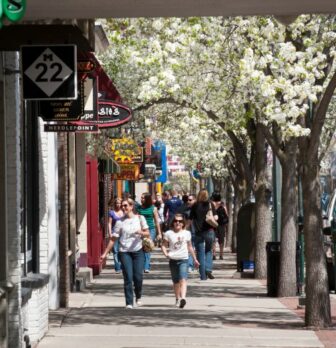In two recent Atlantic articles James Fallows writes about the renaissance in central city downtowns occurring across America and around the world. (You can find the articles here and here.) He concludes that vibrant downtowns are an essential ingredient in city success: He writes:
“Yes, you can find exceptions. But most of the time, when you’ve got a downtown district with a self-sustaining combination of retail outlets (especially nonchain stores); restaurants and bars and brewpubs and music sites (to draw people downtown at night); art or festivals or live events (to give people a civic sense-of-self); and, crucially, residential spaces (where people who don’t have children or whose children have grown up live in second- and third-story apartments above stores and restaurants, providing street life through the evening and a general sense of bustle in downtown)— when find a place with those things, it’s very likely that all the other economic, cultural, civic, and educational indicators of local well-being will be positive too.”
Exactly! Vibrant central city downtowns are a critical economic development asset for cities and regions. Driven largely by the preference of many college educated Millennials to live and work in dense, walkable, transit-rich, amenity-rich neighborhoods. That most characterize downtown and near downtown neighborhoods.
More evidence of the economic development power of vibrant downtown comes from a terrific new report from Smart Growth America in collaboration with global real estate advisors Cushman & Wakefield. The report is titled Core Values: Why American Companies are Moving Downtown. Worth reading!
Cushman and Wakefield identified five hundred companies that have recently located in an American downtown. Smart Growth America interviewed them to find out why a central city downtown. Here is what they found:
Companies across the country want to be in walkable, downtown neighborhoods. This report highlights just some of the many companies at the forefront of this emerging trend.
This trend is happening with companies of all sizes—from just a few people to many thousand. They represent a diverse variety of industries, and include everything from startups to some of the most successful companies in the country. They are moving not just to big cities on the coasts, but to mid-size cities in nearly every state in the nation.
Companies’ motivations for these moves are diverse. Many chose downtown to attract and retain talented workers. Some want to reinforce their brand identity or to create a dynamic company culture. Some want the creativity and opportunity for collaboration a downtown location provides. Some want to be closer to customers or partners or to centralize operations. And some want to use their sizable investing power to support a city’s renaissance and other triple-bottom-line business outcomes. The companies included in our survey see competitive advantages in each of these. Other companies considering where to move would do well to consider these points when deciding on a new location.
Though their motives are diverse, common themes emerged about what these companies looked for when choosing a new location. Nearly all opted for vibrant, walkable neighborhoods where people want to both live and work. Some companies emphasized having a range of transportation options, with easy commutes for employees living in the suburbs as well as downtown. Great office space was another important factor, and many companies highlighted unique and inspired architecture that dovetailed with a broader company emphasis on creativity. A warm welcome from the city also factored in to many companies’ decision making process. And finally, companies explained that a clean, safe downtown was a fundamental requirement for their choice of where to move.
Municipal leaders can learn important lessons from all of this. Many towns and cities already have walkable, downtown neighborhoods that are well-positioned to attract the companies discussed here. Those that do not can take proactive measures to create these kinds of places. As this research hopefully makes clear, creating great-quality neighborhoods is an economic development strategy that can attract jobs and new businesses—in fact, it already is.
These are important lessons for Michigan policy makers to learn. State, regional and city leaders all need to pay heed to this trend. By and large Michigan political and business leadership is behind the times in understanding the importance of placemaking to economic growth. If we want to retain and attract businesses, particularly high-wage knowledge-based businesses, we need to create the kind of neighborhood attributes Fallows writes about at far greater scale in our cities––particularly Detroit and Grand Rapids.






